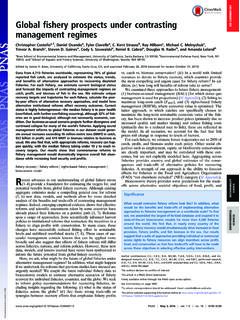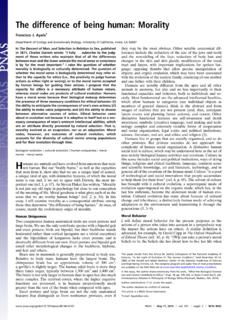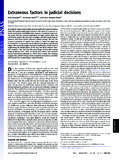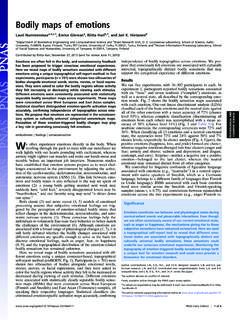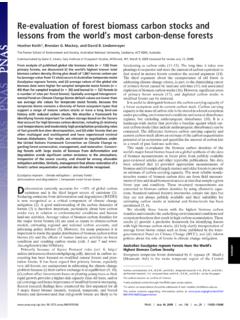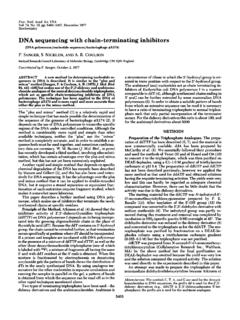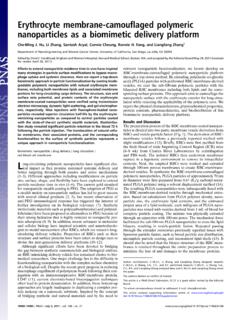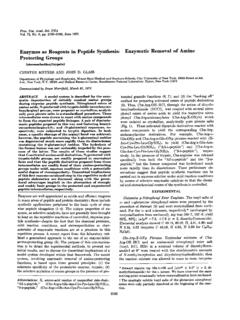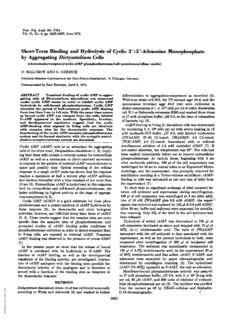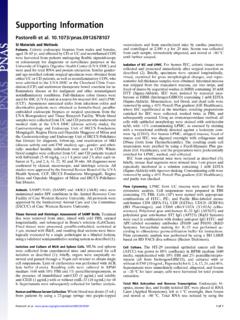Transcription of The synaptic vesicle protein SV2A is the binding site …
1 The synaptic vesicle protein SV2A is the binding sitefor the antiepileptic drug levetiracetamBerkley A. Lynch* , Nathalie Lambeng , Karl Nocka , Patricia Kensel-Hammes , Sandra M. Bajjalieh , Alain Matagne ,and Bruno Fuks Departments of *Molecular and Cellular Biology and Bioinformatics and Target Discovery, UCB Research Inc., 840 Memorial Drive, Cambridge, MA 02139;Departments of In Vitro Pharmacology and CNS Pharmacology, UCB , Pharma Sector, Chemin du Foriest, B-1420 Braine L Alleud, Belgium; and Department of Pharmacology, University of Washington, D429 HSB, Box 357280, Seattle, WA 98195-7280 Edited by William A. Catterall, University of Washington School of Medicine, Seattle, WA, and approved May 17, 2004 (received for reviewDecember 10, 2003)Here, we show that the synaptic vesicle protein SV2A is the brainbinding site of levetiracetam (LEV), a new antiepileptic drug witha unique activity profile in animal models of seizure and LEV- binding site is enriched in synaptic vesicles, and photoaf-finity labeling of purified synaptic vesicles confirms that it has anapparent molecular mass of 90 kDa.
2 Brain membranes andpurified synaptic vesicles from mice lacking SV2A do not bind atritiated LEV derivative, indicating that SV2A is necessary for LEVbinding. LEV and related compounds bind to SV2A expressed infibroblasts, indicating that SV2A is sufficient for LEV binding . Nobinding was observed to the related isoforms SV2B and , there is a high degree of correlation between bindingaffinities of a series of LEV derivatives to SV2A in fibroblasts andto the LEV- binding site in brain. Finally, there is a strong correlationbetween the affinity of a compound for SV2A and its ability toprotect against seizures in an audiogenic mouse animal model ofepilepsy. These experimental results suggest that SV2A is thebinding site of LEV in the brain and that LEV acts by modulating thefunction of SV2A, supporting previous indications that LEV pos-sesses a mechanism of action distinct from that of other antiepi-leptic drugs.
3 Further, these results indicate that proteins involvedin vesicle exocytosis, and SV2 in particular, are promising targetsfor the development of new CNS drug , a group of diseases characterized by recurrentspontaneous seizures, is a prevalent chronic neurologicaldisorder (1). An often devastating disease, epilepsy is frequentlyresistant to conventional antiepileptic drugs (AEDs), even whenthey are used in polytherapy (1). Traditional AEDs mainly targetion channels or postsynaptic receptors. Given that traditionalAEDs do not control seizures in all patients, identification ofalternative molecular pathways and targets for therapeutic in-tervention in epilepsy is warranted. Levetiracetam [LEV; (S)- -ethyl-2-oxo-pyrrolidine acetamide; KEPPRA] is an antiepi-leptic drug approved by the Food and Drug Administration inthe year 1999 as an adjunctive therapy for the treatment ofrefractory partial epilepsy in adults (2, 3).
4 LEV possesses severalproperties that distinguish it from classical AEDs (4). It has adistinctive pharmacological profile in animal models of seizuresand epilepsy, as demonstrated by its lack of activity in the acuteseizure models traditionally used to screen for antiepilepticdrugs (5). This lack of activity against acutely generated seizurescontrasts LEV s potent seizure protection in animal models ofchronic epilepsy, including genetic and kindling models (5).Compared with traditional AEDs, LEV has the ability to inhibitneuronal hypersynchronization when epileptiform activity isevoked in rat hippocampal slices (6, 7). Also exceptional amongAEDs is LEV s ability to counteract the development of amyg-dala electrical kindling in rodents even after drug dosing isterminated (8).LEV s pharmacological profile has been presumed to relate toa distinctive mechanism of action (9).
5 Additionally, LEV doesnot seem to act by means of any of the three main mechanismscurrently accepted for the antiseizure action of establishedAEDs: (i) -aminobutyratergic (GABA ergic) facilitation, (ii)inhibition of Na channels, or (iii) modulation of low-voltageactivated Ca2 currents (9, 10). Previous studies revealed thatLEV binds saturably, reversibly, and stereospecifically to anunidentified binding site in rat brain (11). Screening of a largenumber of known AEDs and other neuroactive compoundsfailed to identify any with high affinity for the LEV- binding site(11), providing support for the novelty of the LEV- binding a series of LEV analogs revealed a strong correlationbetween their affinities for the brain binding site and theirantiseizure potencies in the audiogenic mouse model of epilepsy(11). This finding indicates a functional role for the unidentifiedbrain binding site in the antiseizure actions of of a LEV- binding site in brain provided the ratio-nale to search for the LEV- binding molecule.
6 Further charac-terization of the binding site led to its classification as an integralmembrane protein of widespread distribution in brain, localizedin neurons and enriched in the synaptic vesicle membranefraction (11, 12). SDS PAGE on the LEV- binding protein frombrain membranes cross-linked to a tritiated photoaffinity LEVderivative determined that the protein has an apparent molec-ular mass of 90 kDa (12). Among possible candidate proteinsmatching these characteristics is the synaptic vesicle protein 2(SV2).SV2, an integral membrane protein present on all synapticvesicles, is a small gene family consisting of three isoforms,designated SV2A, SV2B, and SV2C. SV2A is the most widelydistributed isoform, being nearly ubiquitous in the CNS, as wellas being present in endocrine cells (13, 14). SV2B is brainspecific, with a wide but not ubiquitous distribution, and SV2 Cis a minor isoform in brain.
7 The brain distribution of theLEV- binding site, as revealed by autoradiography, matches theequivalent distribution of SV2A as determined by immunocy-tochemistry (14, 15). Both SV2A / and SV2B / homozygousknockout (KO) mice have been reported, as well as double A BKOs (16, 17). SV2A and SV2A B KOs exhibit a severe seizurephenotype whereas the SV2B KOs do not. Studies of the SV2 KOs indicate that SV2 has a crucial role in the regulation ofvesicle function, although not in vesicle biogenesis or synapticmorphology (16, 17).Here, we report studies designed to test the hypothesis thatSV2 is the LEV- binding site. We demonstrate that the proteinSV2A is the LEV- binding site in brain and that there is anexcellent correlation between the binding affinity of LEV andderivatives in brain and to heterologously expressed humanThis paper was submitted directly (Track II) to the PNAS : AED, antiepileptic drug; LEV, levetiracetam; SV2, synaptic vesicle protein 2;hSV2A, human SV2A; KO, knockout; -gal, -galactosidase; DM,n-dodecyl- -D-maltoside;[3H]ucb 30889, (2S)-2-[4-(3-azidophenyl)-2-oxopyrrolidi n-1-yl]butanamide; pIC50, logIC50.
8 To whom correspondence should be addressed. E-mail: 2004 by The National Academy of Sciences of the cgi doi June 29, 2004 vol. 101 no. 26 9861 9866 PHARMACOLOGYSV2A in fibroblasts. These data have implications for themechanism of action of LEV as an antiepileptic drug, andpotentially for future research into the contribution of presyn-aptic mechanisms to seizure initiation and propagation in and and derivatives were synthesized at UCB Pharma.[3H]ucb 30889, (2S)-2-[4-(3-azidophenyl)-2-oxopyrrolidi n-1-yl]butanamide (32 Ci mmol; 1 Ci 37 GBq), was customlabeled by Amersham and SV2 KO animal experiments were approved bythe local ethics committee for animal experimentation, accord-ing to and Belgian law. SV2A KO mice have been reported(16). SV2B KOs were bred with animals heterozygous for theSV2A gene disruption to produce SV2A / SV2B / breeders,which were used to generate SV2A B KOs.
9 WT C57BL 6 andSV2 KO mouse brain membranes for Western blot and bindinganalyses were prepared as follows. Frozen whole brains werehomogenized (10% wt vol) in 20 mM Tris HCl buffer (pH )containing 250 mM sucrose (buffer A). The homogenates werespun at 30,000 gat 4 C for 15 min, and the pellets wereresuspended in the same buffer. After incubation at 37 C for 15min, the membranes were washed two times, resuspended inbuffer A, and Labeling of crude synapto-somal (P2) and synaptic vesicle (LP2) fractions from rat brainwas performed as reported (12), except that the LP2 fraction waswashed at 100,000 gfor 60 min. Photoaffinity labeling wasperformed as described (12), except for using synaptic vesiclefractions instead of brain membranes. The inclusion of 1 mMLEV in the reaction was shown to prevent the photolabeling. Forsize analysis of the labeled binding site, membranes were ex-tracted and run on SDS PAGE.
10 The developed gel was sliced,and the slices were solubilized and counted as described (12). synaptic vesicle Purification from WT and KO vesicleswere purified by using the technique of Huttneret al. (18) asdescribed (19), except that the final two centrifugation steps weredone by using a SW 50 and Expression of SV2 SV2A (hSV2A)was PCR-amplified from a human fetal brain cDNA with addedGATEWAY (Invitrogen) attB1 and attB2 f lanking resultant product was cloned by recombination into apDONR201 vector (Invitrogen). hSV2B and hSV2C were PCR-amplified from first-strand cDNA synthesized from human adultbrain total RNA (Ambion, Austin, TX) and recombined by TAcloning into a GATEWAY pENTR SD D vector (Invitrogen).All three isoforms were recombined into pd40 expression vectors(Invitrogen), supporting expression of the native, nonfusedprotein from a cytomegalovirus immediate-early promoter.
